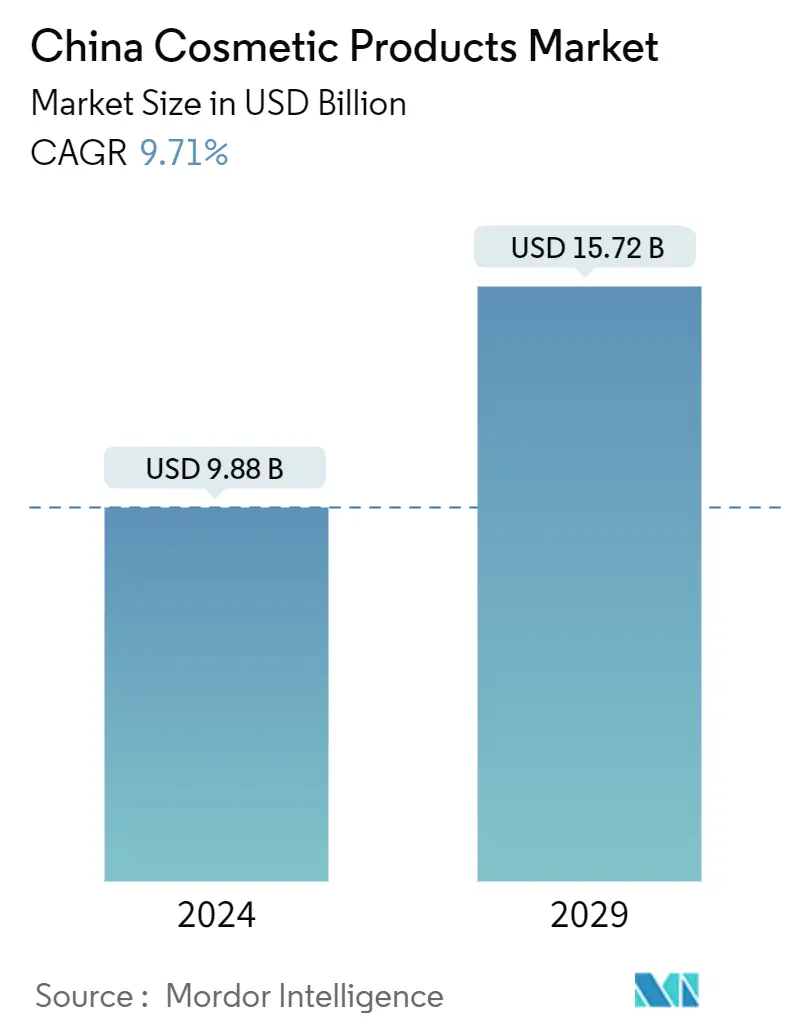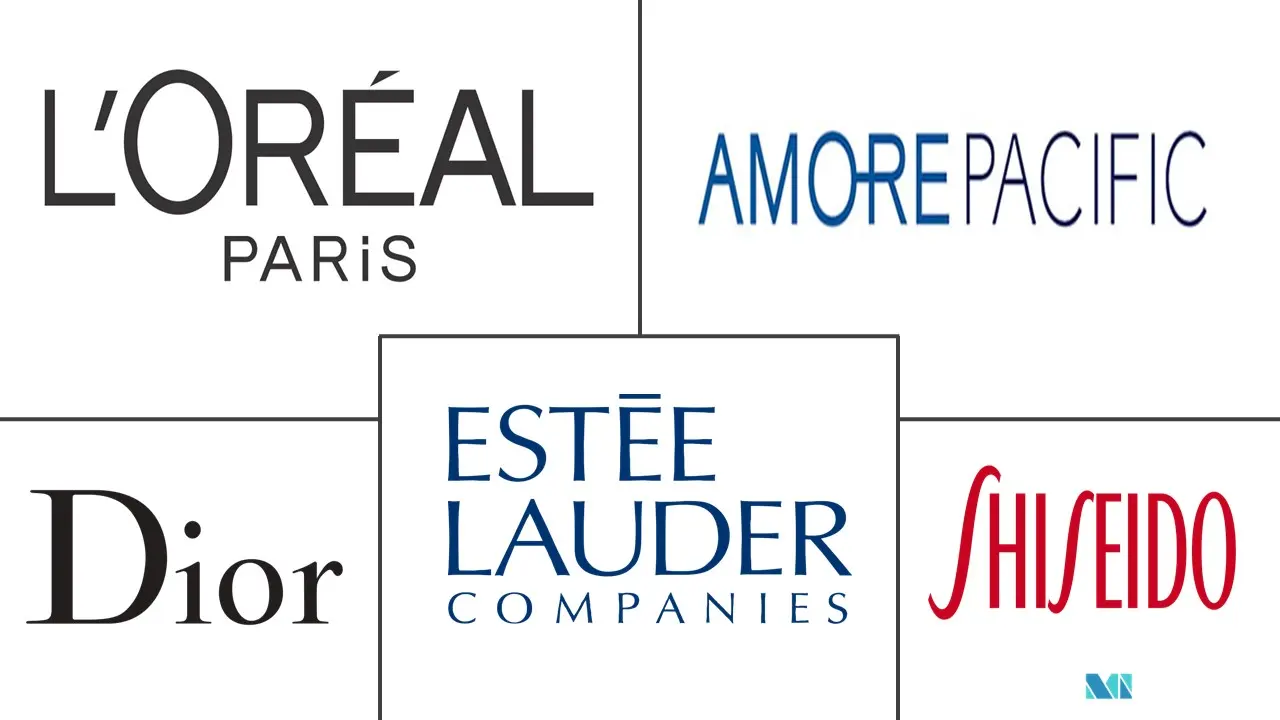Market Size of China Cosmetic Products Industry

| Study Period | 2019 - 2029 |
| Base Year For Estimation | 2023 |
| Market Size (2024) | USD 9.88 Billion |
| Market Size (2029) | USD 15.72 Billion |
| CAGR (2024 - 2029) | 9.71 % |
| Market Concentration | Low |
Major Players
*Disclaimer: Major Players sorted in no particular order |
China Cosmetics Products Market Analysis
The China Cosmetic Products Market size is estimated at USD 9.88 billion in 2024, and is expected to reach USD 15.72 billion by 2029, growing at a CAGR of 9.71% during the forecast period (2024-2029).
Consumers in China are becoming conscious of their external beauty and are making greater use of cosmetics products. They are increasingly incorporating cosmetics products in their daily routine, attributed to the rising concern for beauty and changing lifestyles, fuelling the market demand for cosmetics products.
- Also, the increase in the number of working women has led to an increased demand for premium products owing to growing disposable incomes. Furthermore, consumers in the market are seeking plant-based and natural botanical ingredients-based products that offer multi-functional properties due to growing consumer skepticism about the adverse effects of chemicals and synthetic ingredients on the skin.
- Consumers are also demanding functional cosmetics products that fulfill not only basic moisturizing needs but also offer professional-level skincare. As a result, the players in the market are focussing on expanding their presence in the country to capture the market's potential.
- For instance, in May 2021, Qingdao Baheal Medical Inc. launched China's first commercialization platform for functional cosmetics to facilitate such brands to enter the market through medical standards, consumer experience improvement, and precision marketing programs.
China Cosmetics Products Industry Segmentation
Cosmetic products are mixtures of chemical compounds that are either produced naturally or are created synthetically. These products are designed for personal care and skin care.
The China cosmetics products market is segmented by product type, category, and distribution channel. Based on product type, the market is segmented into color cosmetics, hairstyling, and coloring products. The color cosmetics segment is further segmented into facial make-up, eye make-up, lip, and nail make-up. Based on category, the market studied is segmented into mass and premium products. Based on the distribution channel, the market studied is segmented into supermarkets/hypermarkets, convenience/grocery stores, specialty stores, pharmacies and drug stores, online retail stores, and other distribution channels.
For each segment, the market sizing and forecasts have been done on the basis of value (in USD million).
| By Product Type | |||||
| |||||
| Hair Styling and Coloring Products |
| By Category | |
| Mass | |
| Premium |
| By Distribution Channel | |
| Supermarkets/Hypermarkets | |
| Convenience/Grocery Stores | |
| Specialty Stores | |
| Pharmacies and Drug Stores | |
| Online Retail Stores | |
| Other Distribution Channels |
China Cosmetic Products Market Size Summary
The China cosmetics market is experiencing significant growth, driven by a rising consumer consciousness about beauty and an increasing incorporation of cosmetics into daily routines. This trend is fueled by changing lifestyles and a growing demand for premium products, particularly among working women with higher disposable incomes. Consumers are increasingly seeking products with plant-based and natural botanical ingredients, reflecting a skepticism towards chemicals and synthetic components. The demand for functional cosmetics that offer advanced skincare benefits is also on the rise. Market players are expanding their presence in China to capitalize on these trends, with initiatives like the launch of China's first commercialization platform for functional cosmetics by Qingdao Baheal Medical Inc.
The shift towards natural and clean-label products is prominent, with consumers favoring vegan, organic, and minimally processed beauty items. Sustainability is a key focus, with companies introducing eco-friendly products and sustainable packaging to meet consumer preferences. The rise of online retail, driven by limited brand diversity and retail access, is reshaping the market, with e-commerce and live streaming becoming major sales channels. The competitive landscape includes both established foreign brands and regional players, with a focus on innovative product offerings and effective branding strategies. Prominent market players such as L'Oreal Group, Estée Lauder, and Shiseido are actively engaging in these trends to enhance their market share in China.
China Cosmetic Products Market Size - Table of Contents
-
1. MARKET DYNAMICS
-
1.1 Market Drivers
-
1.2 Market Restraints
-
1.3 Porter's Five Forces Analysis
-
1.3.1 Threat of New Entrants
-
1.3.2 Bargaining Power of Buyers/Consumers
-
1.3.3 Bargaining Power of Suppliers
-
1.3.4 Threat of Substitute Products
-
1.3.5 Intensity of Competitive Rivalry
-
-
-
2. MARKET SEGMENTATION
-
2.1 By Product Type
-
2.1.1 Color Cosmetics
-
2.1.1.1 Facial Make-up
-
2.1.1.2 Eye Make-up
-
2.1.1.3 Lip and Nail Make-up
-
-
2.1.2 Hair Styling and Coloring Products
-
-
2.2 By Category
-
2.2.1 Mass
-
2.2.2 Premium
-
-
2.3 By Distribution Channel
-
2.3.1 Supermarkets/Hypermarkets
-
2.3.2 Convenience/Grocery Stores
-
2.3.3 Specialty Stores
-
2.3.4 Pharmacies and Drug Stores
-
2.3.5 Online Retail Stores
-
2.3.6 Other Distribution Channels
-
-
China Cosmetic Products Market Size FAQs
How big is the China Cosmetic Products Market?
The China Cosmetic Products Market size is expected to reach USD 9.88 billion in 2024 and grow at a CAGR of 9.71% to reach USD 15.72 billion by 2029.
What is the current China Cosmetic Products Market size?
In 2024, the China Cosmetic Products Market size is expected to reach USD 9.88 billion.

